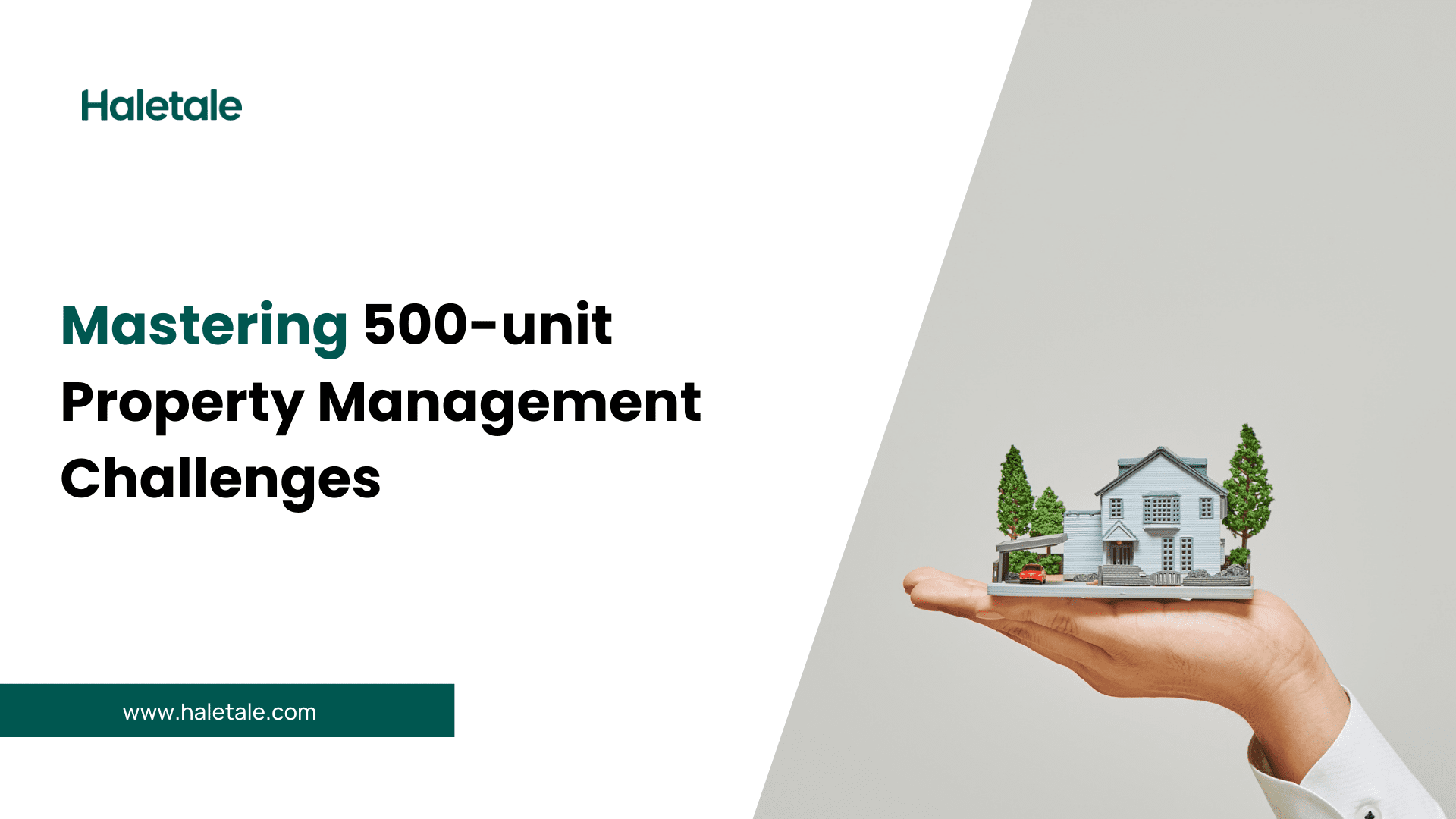The Evolution of Large-Scale Property Operations: Navigating the Complexities of 500+ Unit Portfolios
The Watershed Moment: When Traditional Methods Meet Their Limits
There’s a pivotal moment in every property manager’s journey—usually somewhere around the 500-unit mark—when the systems and processes that got you to this point suddenly feel inadequate. It’s not just about scale; it’s about the fundamental shift in operational complexity that comes with managing hundreds of units across multiple markets.
Consider this: about 35% of property managers currently handle between 101 and 500 units, but very few successfully scale beyond that threshold without completely reimagining their operational framework. The leading property management company now oversees 798,272 rental units—a testament to what’s possible when the right infrastructure meets strategic vision.
The challenges aren’t merely multiplicative; they’re exponential:
Geographic Complexity: Managing properties across different municipalities means navigating varying regulations, market conditions, and vendor networks simultaneously. What works in Toronto doesn’t necessarily translate to Vancouver or Montreal.
Financial Intricacy: With revenue streams flowing from hundreds of units across diverse property types, traditional accounting methods become not just inefficient, but potentially risky. The U.S. property management market alone is expanding from $81.52 billion to $98.88 billion by 2029 (source)—indicating both opportunity and competitive pressure.
Technology Integration Gaps: While 67% of companies use property management software, only 48% have implemented automated lease management systems. This fragmentation becomes a critical vulnerability at scale.
The question isn’t whether you need better systems—it’s whether you’re willing to embrace the fundamental changes required to succeed at this level.
Rethinking Operational Architecture for Multi-Site Success
Challenges in 500-Unit Property Management
Beyond Basic Centralization
Most property managers understand the concept of centralization, but few grasp its true implications at scale. It’s not just about having one dashboard to view multiple properties—it’s about creating an operational nervous system that can process, analyze, and respond to hundreds of simultaneous inputs.
The most successful large-scale operators have discovered that effective centralization requires three core components:
Unified Decision-Making Frameworks: Every property-level decision—from maintenance prioritization to lease renewals—must flow through consistent evaluation criteria. This doesn’t mean micromanagement; it means establishing clear protocols that maintain quality standards regardless of location.
Integrated Communication Networks: When managing 500+ units, information silos become operational killers. The most effective platforms we’ve observed create seamless communication flows between tenants, on-site staff, contractors, and management—eliminating the telephone game that plagues many large operations.
Scalable Process Documentation: Standard Operating Procedures (SOPs) at this scale aren’t just helpful—they’re essential for maintaining consistency and enabling rapid growth. Every process, from tenant screening to emergency response, needs to be documented, trainable, and replicable.
The Technology Infrastructure Reality
Here’s what many operators discover too late: the technology stack that supports a 50-unit portfolio won’t scale to 500 units without significant architectural changes. The most successful large-scale operators have moved beyond piecemeal solutions to integrated platforms that handle complexity without creating additional operational overhead.
Modern property management platforms have evolved to address these specific challenges, offering comprehensive solutions that grow with your portfolio rather than constraining it. The key is finding technology that enhances human decision-making rather than replacing it.
The Science of Predictive Operations
Data-Driven Maintenance Revolution
The maintenance paradigm shift happening across the industry represents one of the most significant operational advances in decades. According to U.S. Department of Energy research, predictive maintenance delivers 8-12% savings on preventive maintenance and up to 40% reduction in reactive maintenance costs.
For a 500-unit portfolio, these numbers translate to substantial operational improvements:
Historical Pattern Recognition: Advanced analytics can identify maintenance trends across your entire portfolio, revealing insights that aren’t visible at the property level. For instance, HVAC systems in similar buildings might show predictable failure patterns based on installation dates, usage patterns, or local climate conditions.
Resource Optimization: National Institute of Standards and Technology studies show that operations relying heavily on predictive rather than preventive maintenance experience up to 87% fewer equipment defects. At scale, this means fewer emergency calls, more efficient scheduling, and significantly lower total maintenance costs.
Portfolio-Wide Intelligence: The most sophisticated operators are discovering that maintenance data from one property can inform decisions across their entire portfolio. Patterns in plumbing failures, HVAC performance, or appliance longevity provide predictive insights that improve investment decisions and operational planning.
Financial Analytics Beyond Basic Reporting
Large-scale portfolio management requires financial intelligence that goes far beyond traditional accounting. The most successful operators have implemented systems that provide real-time insights into:
Performance Benchmarking: Comparing similar properties across different markets reveals optimization opportunities that aren’t apparent when examining properties in isolation. Rent-per-square-foot variations, operating expense ratios, and tenant retention rates become powerful strategic tools when analyzed across portfolios.
Cost Center Analysis: Understanding which properties, building types, or geographic markets drive profitability enables more informed investment decisions. The most effective platforms provide granular cost tracking that identifies optimization opportunities at both property and portfolio levels.
Modern platforms like Haletale’s comprehensive analytics suite have made these capabilities accessible to mid-market operators, democratizing insights that were previously available only to institutional-scale operations.
Tenant Experience Engineering at Scale
The Consistency Challenge
One of the most underestimated challenges in large-scale property management is maintaining consistent tenant experiences across diverse properties and markets. Research shows that 74% of renters prioritize energy-efficient properties, 54% prefer smart home features, and 80% prefer online rent payment—but delivering these expectations consistently across hundreds of units requires systematic approach.
Standardized Digital Touchpoints: The most successful large-scale operators have realized that tenant experience engineering begins with digital infrastructure. Consistent online portals, mobile accessibility, and communication protocols create baseline expectations regardless of property age or location.
Service Level Agreements: Internal SLAs for maintenance response, communication timing, and problem resolution ensure that tenant experience quality doesn’t degrade as portfolio size increases. The key is creating measurable standards that can be monitored and improved systematically.
Feedback Integration Systems: At scale, tenant feedback becomes a valuable data source for operational improvement. Comprehensive tenant portal systems enable systematic feedback collection and response tracking, turning tenant satisfaction into a competitive advantage.
Technology as Experience Enabler
The distinction between successful and struggling large-scale operators often comes down to how effectively they leverage technology to enhance rather than replace human interaction. The most effective platforms provide:
Automated Routine Tasks: Rent reminders, lease renewal notices, and basic maintenance scheduling can be automated without losing personal touch. This frees human resources for complex problem-solving and relationship building.
Intelligent Communication Routing: Advanced platforms can route tenant communications to appropriate team members based on issue type, property location, and staff expertise. This ensures faster response times while maintaining personal accountability.
Predictive Issue Resolution: Analytics can identify potential tenant concerns before they become complaints, enabling proactive outreach and problem resolution. This approach transforms property management from reactive customer service to proactive relationship management.
Strategic Technology Selection for Large-Scale Success
The Integration Imperative
Perhaps the most critical decision large-scale operators face is choosing technology that integrates seamlessly across all operational areas. The cost of managing multiple disconnected systems—in both time and operational inefficiency—becomes prohibitive at scale.
Single-Source-of-Truth Architecture: The most successful platforms provide unified data management where financial information, maintenance records, tenant communications, and operational metrics exist in connected systems rather than isolated silos.
Scalable Customization: Large portfolios often include diverse property types, markets, and operational requirements. The best platforms provide customization capabilities that accommodate this diversity without creating management complexity.
API-First Design: Future-proofing requires platforms that can integrate with emerging technologies and specialized tools. API-first architecture ensures that your core platform can evolve with your operational needs.
The Canadian Market Advantage
For Canadian operators, regulatory compliance and market understanding become critical platform selection criteria. The most effective solutions provide built-in intelligence about provincial regulations, tax requirements, and market dynamics.
Platforms like Haletale demonstrate this market focus through regular compliance updates and regional expertise that generic platforms simply cannot match.
Specialized Operations: Beyond Traditional Property Management
Co-Living and Shared Space Complexity
The evolution toward shared living spaces—from co-living to student housing—introduces operational complexities that traditional property management systems weren’t designed to handle. Room-level leasing, utility splitting, and shared space maintenance require sophisticated operational approaches.
Room-Level Financial Management: Tracking rent, deposits, and expenses at the individual room level while maintaining property-level financial oversight requires specialized capabilities that few platforms provide effectively.
Community Management: Shared living spaces require community management approaches that go beyond traditional landlord-tenant relationships. This includes conflict resolution, shared resource scheduling, and community event coordination.
Regulatory Navigation: Shared living arrangements often exist in regulatory gray areas, requiring platforms that can adapt to evolving legal frameworks while maintaining operational efficiency.
Specialized co-living management platforms have evolved to address these challenges, providing room-level lease management, automated utility splitting, and community coordination tools.
Short-Term Rental Integration
The line between traditional rental management and short-term rental operations continues to blur, especially for large-scale operators seeking revenue optimization. Successfully managing both traditional and short-term rentals within the same portfolio requires integrated approaches that maintain operational efficiency across different business models.
Dynamic Pricing Intelligence: Short-term rental success depends on pricing optimization that responds to market conditions, seasonal patterns, and local events. The most sophisticated operators use integrated platforms that coordinate pricing across both short and long-term rental strategies.
Operational Flexibility: Properties may transition between short-term and long-term rental strategies based on market conditions, requiring platforms that accommodate these changes without operational disruption.
Building Resilient Operations for Future Growth
The Sustainability Integration
Environmental regulations and sustainability expectations are reshaping property management requirements. Natural disasters now cause $318 billion in global economic losses annually, with insured losses expected to reach $145 billion in 2025. This reality makes sustainable operations both an environmental and financial imperative.
Energy Efficiency Monitoring: Advanced platforms now provide energy usage tracking across portfolios, enabling identification of efficiency opportunities and compliance with evolving environmental regulations.
Preventive Maintenance for Longevity: IoT-enabled predictive maintenance can improve energy efficiency by 25% while reducing long-term capital expenditure through extended asset life cycles.
ESG Reporting Capabilities: Institutional investors increasingly require environmental, social, and governance reporting from property operations. Platforms that provide integrated ESG tracking and reporting capabilities position operators for future capital access and regulatory compliance.
The Human Element at Scale
Despite technological advancement, the most successful large-scale operators understand that technology amplifies human capability rather than replacing it. The key is creating systems that enhance decision-making, improve communication, and enable staff to focus on high-value activities.
Data-Informed Decision Making: The best platforms provide decision support rather than automated decision-making, ensuring that human expertise guides strategic choices while leveraging data insights.
Staff Development and Training: Scalable operations require consistent staff capabilities across all properties. Platforms that provide integrated training resources and performance tracking enable consistent service delivery as portfolios expand.
Tenant Relationship Management: At scale, maintaining personal relationships becomes challenging but not less important. Technology should enable more meaningful interactions by automating routine tasks and providing relationship intelligence.
Implementation Strategy for Large-Scale Success
The Phased Approach
Transitioning to enterprise-level operations requires careful planning and systematic implementation. The most successful large-scale operators avoid the “big bang” approach in favor of strategic, phased transitions that minimize operational disruption while building capabilities progressively.
Foundation Building: Establishing core operational infrastructure—unified communication systems, standardized processes, and integrated financial management—creates the foundation for subsequent scaling.
Capability Expansion: Gradually adding advanced features like predictive analytics, automated workflows, and specialized property type support allows teams to adapt to new capabilities while maintaining operational stability.
Optimization and Refinement: Once core capabilities are established, focus shifts to optimization and continuous improvement based on performance data and operational experience.
Team Development for Scale
Large-scale operations require different skill sets than smaller portfolios. The most successful operators invest in team development that matches technological capabilities with human expertise.
Technical Competency: Staff need training on advanced platform capabilities to maximize operational efficiency and data utilization.
Process Management: Standardized operations require staff who understand and can execute consistent processes while adapting to local conditions and specific situations.
Strategic Thinking: Large-scale success depends on team members who can think systematically about operational improvements and growth opportunities.
The Path Forward: Choosing Your Technology Partner
Beyond Feature Comparison
Selecting the right platform for large-scale operations requires looking beyond feature lists to understand how different solutions support operational philosophy and growth strategies.
Scalability Architecture: Platforms should demonstrate capability to handle current operations while providing clear growth paths for expansion. This includes both technical scalability and operational workflow flexibility.
Support Infrastructure: Large-scale operations require responsive, expert support. The most effective platforms provide dedicated support teams with deep property management expertise rather than generic technical support.
Integration Ecosystem: Future operational success depends on platform ability to integrate with emerging technologies and specialized tools. Open architecture and API availability become critical selection criteria.
Regional Expertise Matters
For Canadian operators, platform selection should prioritize solutions with deep local market understanding. Regulatory compliance, tax integration, and market intelligence become differentiating factors that generic platforms cannot provide.
The most successful large-scale operators we’ve observed have chosen platforms that combine operational sophistication with regional expertise—solutions like Haletale that understand both large-scale operational requirements and Canadian market dynamics.
Conclusion: Mastering Complexity Through Strategic Innovation
Successfully managing 500+ unit portfolios requires more than scaling existing processes—it demands fundamental reimagining of operational architecture. The operators who thrive at this level embrace technology not as a replacement for human expertise, but as an amplifier of strategic thinking and operational excellence.
The property management industry is evolving rapidly, with market growth from $21.17 billion to $33.11 billion projected by 2029 (source). This expansion creates opportunities for operators who can master complexity while maintaining service excellence and operational efficiency.
The choice isn’t between technology and human expertise—it’s about finding the right integration that enhances both. The most successful large-scale operators have discovered that platforms which combine operational sophistication with practical usability enable growth without sacrificing quality or profitability.
As you evaluate your own scaling strategy, remember that the goal isn’t just managing more properties—it’s building sustainable operations that can adapt to market changes, regulatory evolution, and growth opportunities while consistently delivering exceptional tenant experiences and strong financial performance.
The future belongs to operators who can master complexity through strategic technology adoption while maintaining the human touch that differentiates exceptional property management from mere transaction processing.
Strategic Insights: Key Questions for Large-Scale Operators
Q1: How do you maintain service consistency across 500+ units in different markets?
A: Successful large-scale operations rely on standardized processes, integrated communication systems, and technology platforms that provide unified oversight while accommodating local variations. The key is creating operational frameworks that scale consistently while maintaining flexibility for market-specific requirements.
Q2: What’s the most critical technology capability for large-scale property management?
A: Integration capability tops the list. Managing 500+ units requires platforms that connect financial management, maintenance coordination, tenant communication, and operational analytics in unified systems rather than disconnected tools that create information silos and operational inefficiencies.
Q3: How can predictive maintenance impact large portfolio operations?
A: U.S. Department of Energy research shows 8-12% savings on preventive maintenance and 40% reduction in reactive maintenance costs. For large portfolios, this translates to substantial cost reduction, improved tenant satisfaction, and more strategic resource allocation across properties.
Q4: What financial analytics capabilities matter most at scale?
A: Real-time performance benchmarking across properties, predictive revenue modeling, and granular cost center analysis become essential for large-scale success. These capabilities enable strategic decision-making about rent optimization, capital improvements, and expansion opportunities.
Q5: How do you handle specialized property types within large portfolios?
A: Diversified portfolios often include co-living spaces, student housing, or short-term rentals alongside traditional properties. Success requires platforms that accommodate room-level management, utility splitting, dynamic pricing, and specialized regulatory requirements without creating operational complexity.
Q6: What role does regulatory compliance play in platform selection?
A: Compliance becomes critical at scale, especially across different jurisdictions. Platforms with built-in regulatory intelligence, automated documentation, and regional expertise significantly reduce compliance risk while enabling focus on operational optimization.
Q7: How important is mobile accessibility for large-scale operations?
A: Mobile capabilities enable real-time operational oversight, field staff efficiency, and responsive tenant communication. Large-scale success often depends on management teams’ ability to monitor and respond to operational issues regardless of location or time.
Q8: What support infrastructure do large-scale operators require?
A: Large portfolios need responsive, expert support that understands complex operational challenges. The most effective platforms provide dedicated support teams with property management expertise rather than generic technical assistance.
Q9: How do you balance automation with human expertise at scale?
A: The most successful operators use technology to automate routine tasks while preserving human involvement in strategic decisions, complex problem-solving, and relationship management. Technology should amplify human capability rather than replacing professional judgment.
Q10: What implementation approach works best for large-scale technology transitions?
A: Phased implementation minimizes operational disruption while building capabilities progressively. Start with core infrastructure, expand capabilities systematically, and focus on team development throughout the transition to ensure both technological and operational success.
The evolution toward large-scale property management represents both significant opportunity and operational challenge. Success requires strategic thinking, appropriate technology selection, and commitment to operational excellence that scales with growth.









